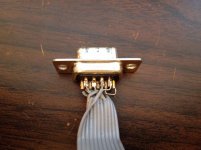A lot of old Multisync monitors had a nine pin connector, so, yes, not that weird in and of itself. Remember, these monitors often predated the introduction of VGA which didn't debut until April 1987; heck, the Macintosh II, which used similar resolution analog monitors *slightly* beat VGA to market and the IBM PGC was introduced all the way back in 1984. The issue is that the 9 pin connector was never really *standardized*; in any given case it might be carrying TTL, analog, or ELC signals and the pin arrangement might be completely different between manufacturers. (I believe *most* companies used the PGC pinout when carrying analog video but you can't really bet on that being true in any particular instance.)
Again the thing that bothers me is from the pictures of the board I saw (assuming I'm remembering correctly) is it looked like the 9 pin monitor connector used for the full-page monitor on that video board plugged into a different pin-header than the VGA pinout connector. (If they're both carrying analog VGA-compatible video why would you have two different pin-headers instead of just using the same header with differently-plugged pigtails?)
This page has the pinout of a Radius "TPD" (which I assume is "Two page display") that shows a Mac 15 pin connector on one end terminating in a simple BNC connector on the other end; I wonder if the output from that 9 pin connector only comes out on two pins (a single pin with combined sync/luminance and a ground return) and is less "VGA" and more like a high frequency composite output. *If* that's the case it's probably not the end of the world, but you'll have to figure out the pinout and... maybe you'd have some luck with a multisync monitor that supports sync-on-green by feeding the signal into the green pin?
(Edit: Digging *way* back into my memory I think I saw one of those full-page-displays at a thrift store once, and while I could well be just post-facto editing the mental image it may well have had a BNC connector on the back. I remember looking at it for a while and wondering if there were any way I might be able to hook it to my 486 before moving on....
And edit again... found a picture of the back panel of a Radius FPD and that's a 9 pin connecter. But still... grrr. Someone *somewhere* must know what the pinout and signal of that is, it's worth a try at least to assume the plug on that card is compatible with it.)


